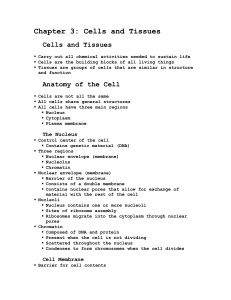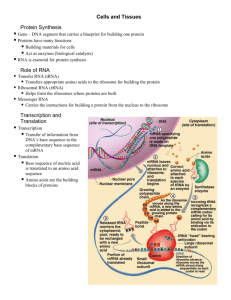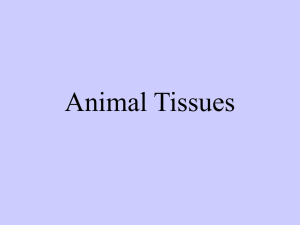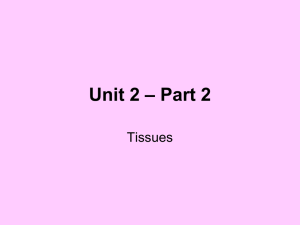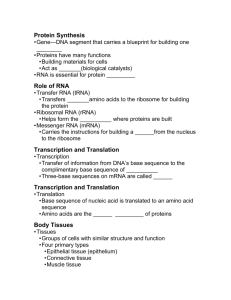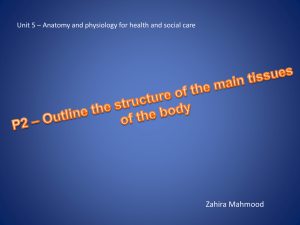Animal Cells, Tissues, and Organs
advertisement
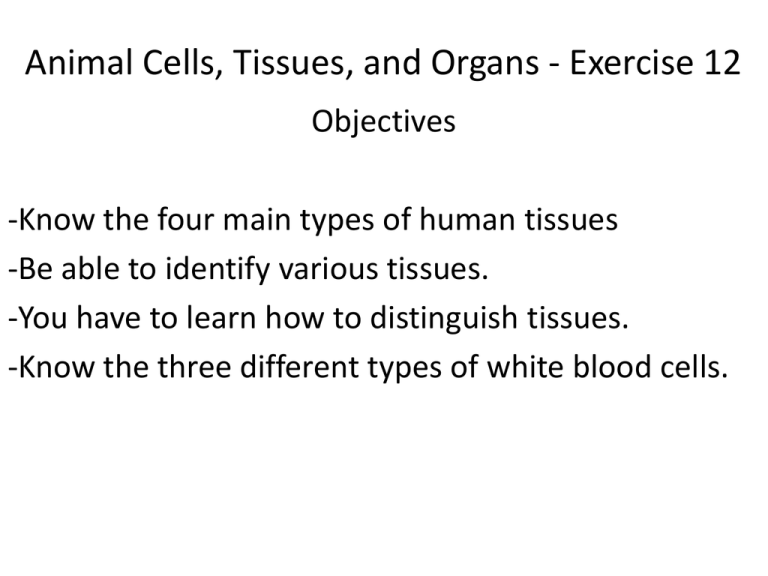
Animal Cells, Tissues, and Organs - Exercise 12 Objectives -Know the four main types of human tissues -Be able to identify various tissues. -You have to learn how to distinguish tissues. -Know the three different types of white blood cells. Page 1 - Lab Book Most multicellular animals exhibit the organization of cells into special types of cells called tissues. In turn, tissues are organized into organs, and organs into organ systems. Although tissue organization is found in both plants and animals, the types of animal tissue are not the same as those found in plants. For example, plants do not have muscle or nervous tissue. • What are the four main tissue types in a human? • What are the four main tissues in a human? Epithelial, Connective, Muscle, and Nerve tissues. • If your going to take Anatomy and Physiology this is going to come back, so keep this in the back of your head. Epithelial Tissue Page 1 - Lab Book Epithelial Tissue: This type of tissue covers the exterior of the body and lines all internal spaces, tubes, and cavities. Epithelial tissue protects the underlying tissues from dehydration and mechanical damage, regulates the passage of materials, may secrete materials into a space, cavity or tube, may absorb materials from a space, cavity, or tube, and may provide sensory functions. • Epithelium is classified according to the shape of its cells. There are 3 types of cell shapes. Major types of epithelial tissues: • Squamos (simple or stratified) à think of “squish” or FLAT • Cuboidal (simple or stratified) à think of “cube” or SQUARE shaped • Columnar (simple) just as the words sounds . . . COLUMN • How do you tell the differentiate between simple vs. stratified epithelium? • Simple this is simple so there is only ONE layer • Stratified opposite of simple . . . so it’s complicated or MULTIPLE layers • Pseudostratified columnar à tricky! It looks like it is stratified, but remember to look for the nuclei at different levels. SO IN reallity this is a simple Columnar epithelium. Simple Cuboidal Epithelium - Kidney Tubles Identify: Cuboidal cell, nucleus Stratified Squamos Epithelium - Esophagus Identify: Stratified Squamos Epithelium & nucleus Pseudostratified Ciliated Columnar Epithelium - Trachea Identify: Cilia, goblet cells , columnar cell, nucleus. Connective Tissue Page 3 - Lab Book This what it sounds like it connects everything together. It’s a diverse group of animal tissue which includes cartilage, bone, ligaments, tendons, blood, and fat. They support the body, hold tissues and organs together, defend the body, and store food. The cells are not tightly packed, but rather are typically suspended and scattered in an extensive extracellular matrix. The classification of connective tissue is based more on function and the nature of the matrix (liquid, fibery, solid) than on the morphology of the cells themselves. Cartilage - Trachea Identify: Chondrocyte, ,lacuna, matrix, & nucleus. Bone (Osseous Tissue) – Ground Bone Identify: Haversion canal, Osteocytes, matrix, & canaliculi Blood – Red Blood Cell aka Erythrocytes (RBC) & White Blood Cell aka leucocytes (WBC) Blood – WBC - Neutrophils Multi-lobed nucleus in which the individual lobes may be connected. Blood – WBC - Monocyte Single curved or horse-shoe shaped nucleus. Blood – WBC - Lymphocyte Nucleus is very large and occupies more than 8590%. Some are called B cells and produce antibodies, and help with immunity. Adipose Tissue (fat) Identify: Cell membrane, nucleus, vacuole. Areolar Tissue Identify: Matrix, collagenous fibers = light pink threads, elastic fibers = hair like structures, fibroblast = cell. Muscle Tissue Page 7 - Lab Book The functions of muscle (contractile) tissue are to move material within the body, move body parts, or move the entire organism in space. All muscle cells execute their function by contracting. There are three types of muscle tissue: Skeletal muscle, smooth muscle, and cardiac muscle. Skeletal Muscle Identify: Striations = black lines, nuclei = black dots, & fiber aka skeletal muscle cells = whole pink/red structure. It’s smooth because its missing striations, but it has all components of muscle cells. Smooth Muscle -Circular layer of smooth muscle = innermost layer (thickest) -longitudinal layer of smooth muscle = outermost layer Identify: Cell membrane, nucleus Nervous Tissue Page 9 - Lab Book This is composed of neurons that transmit nerve impulses and neuroglial cells that support and nourish the neurons. Nervous tissue functions in the coordination of the activities of the organism. Nervous Tissue = neurons – Spinal Cord Identify: Cell body, nucleus, nucleolus, cytoplasmic extension, neuroglial cell. Sperm Cells Identify: Sperm head & flagellum Questions: Page 10-12 - Lab Book • 2. What is the difference between simple and stratified epithelium? • 4. Name two examples of connective tissue that you observed in lab that have a hard and dense matrix? • Name two examples of connective tissue that you observed in lab today that have a soft and watery matrix. • 7. What is the function of a neuron? • What is the main function of glial cells (neuroglia)? Questions: Page 10-12 - Lab Book • 2. What is the difference between simple and stratified epithelium? • 4. Name two examples of connective tissue that you observed in lab that have a hard and dense matrix? Bone and cartilage. • Name two examples of connective tissue that you observed in lab today that have a soft and watery matrix. Blood, lymph, or Areolar • 7. What is the function of a neuron? Send nerve impulses throughout body. • What is the main function of glial cells (neuroglia)? To maintain the neuron, clean it, feed it, and do everything for them. Questions: Page 12 - Lab Book • 8. a) How is an organ different from a tissue? b) How is an organ system different from an organ? Acknowledgments Tacy Holliday Meg Birney Scot Magnotta Kristin Hensley Alam Rashidul Barbara Hoberman & anybody who I forgot




